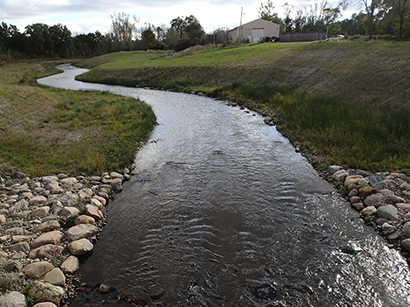|
The Office of Habitat Conservation recently released the results of an external review of NOAA's fish passage activities. In May 2018, an eight-member panel reviewed the goals, prioritization, coordination, effectiveness, and external engagement of NOAA’s fish passage activities for the past 10 years. As a result of the review, the panelists identified areas of strength and opportunities to implement changes that would improve upon program successes, and OHC developed a response outlining priority actions that will address the panel’s key recommendations. Contact: Kara Meckley. Learn More >
 |
As part of restoring the Kalamazoo River watershed from hazardous waste contamination, the Alcott Dam was removed from Portage Creek in Michigan, reopening the creek to fish and other wildlife. The project also provides increased flood protection to surrounding communities. The natural resource Trustees working on the larger Kalamazoo River hazardous waste site—NOAA, the U.S. Fish and Wildlife Service, and multiple agencies in the State of Michigan—provided $2 million for a number of activities. Contact: Julie Sims. Learn More >
Each spring, the NOAA Chesapeake Bay Interpretive Buoy System team redeploys a number of observing platforms, having pulled them to protect from potential overwinter ice damage. This year’s redeployments have a new twist: New buoys! Contact: Kim Couranz. Learn More >
NOAA’s work with community partners restoring estuary habitat in Tillamook Bay, Oregon is revitalizing tidal wetlands for threatened Oregon Coast coho salmon, and helping reduce flooding in the surrounding communities and farmlands. Contact: Lauren Senkyr. Learn More >
The Deepwater Horizon Open Ocean Trustee Implementation Group has approved its Final Restoration Plan 1 and Environmental Assessment: Birds and Sturgeon which selects three projects at a total estimated cost of $16 million. These projects are intended to partially compensate the public for injuries caused by the Deepwater Horizon oil spill to birds and sturgeon, consistent with the Trustees’ Programmatic Restoration Plan. Contact: Laurie Rounds. Learn More >
MWEEs—Meaningful Watershed Educational Experiences—are innovative programs that bring field and classroom learning together to increase environmental literacy. How can educators develop and deliver these innovative learning sessions? NOAA has developed new resources, including a guide and an online course, to help educators implement MWEEs. Contact: Shannon Sprague. Learn More >
Engineering with nature harnesses the natural environmental processes to help maintain beaches, protect roads and structures, and restore habitats. NOAA Fisheries is working with the Army Corps of Engineers’ Philadelphia District and other federal and state agencies to find ways to use existing natural actions to keep shipping and recreational boating channels open, restore wetlands, and protect communities from flooding. Contact: Janine Harris. Learn More >
Thirty years after the Exxon Valdez oil spill, see how the Oil Pollution Act significantly improved measures to prevent, prepare for, and respond to oil spills in U.S. waters. This historic legislation gives NOAA and other agencies the authority to address impacts to natural resources caused by oil spills in U.S. waters and shorelines, and to hold polluters accountable. Contact: Jeff P. Smith. Learn More >
Improving the health of our ocean requires investment, but that investment doesn’t have to be a choice between our planet and our pocketbooks. Sometimes solutions to ocean problems can save money. Oysters and clams are only a small piece of a much larger puzzle. We need to consider the complex ecosystems of which shellfish and other marine life are just parts. Thriving coastal and ocean ecosystems are closely tied to our economy, health, and even our safety. Contact: Learn More >
Check out what NOAA Fisheries is doing to better understand the role habitats plays in our nation’s fishery species in this storymap. U.S. fisheries generate over $200 billion in sales impacts annually. Healthy habitats provide the foundation for these economically vital fisheries as well as a diverse array of marine life that live along our coasts. Habitats provide all the necessities for fishery and marine species to survive and thrive. Contact: John Thibodeau. Learn More >
See new video chronicling FORCE BLUE's efforts, in partnership with NOAA, Nova Southeastern University, Florida Department of Environmental Protection, and Captain Hook's Marina and Dive Center, to halt the spread of Stony Coral Tissue Loss Disease which is currently ravaging the Florida Coral Reef Tract from Martin County to Key West. Contact: Tom Moore. Learn More >
|